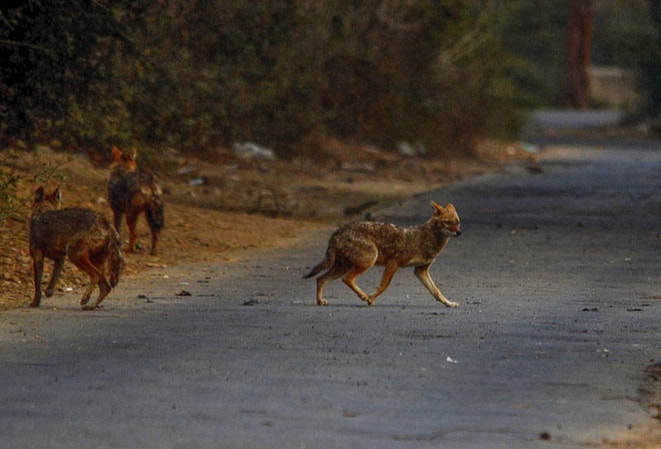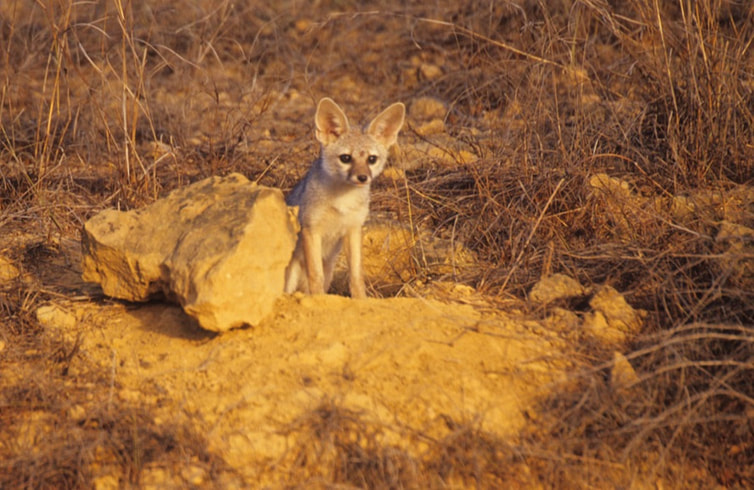|
Nishand Venugopal Jackals are the wild cousins of man’s best friend. Watching them in their habitat will give you an idea about how skillful they are. My first interesting interaction with one of these wild canids was when I visited Sultanpur National Park on a cold morning in January 2017. I never expected to see them there, but while exploring the terrain, I noticed a sudden movement near the grass. A pair of jackals was moving quickly towards the water body. It took me some time to identify them and a bit more to pull out my camera to take a photograph. One of them stopped for a while and turned back to look at me. It gave me a window of a few seconds to take a picture and I did just that! I was so surprised to see them at that time that I even forgot to zoom and take a better picture. I always assumed they live in wild areas but when I saw them again, a year after my first sighting in Sultanpur, I was surprised. I spotted a pack near Delhi, in a small pocket of vegetation surrounded by roads bustling with traffic. Three jackals were crossing the road looking on either side. It was as if they were well aware of the perils of crossing a path made by humans. They are probably trying to adapt to these kinds of changes. My next encounter with a jackal was not a fortunate one. The danger that the earlier pack was trying to avoid did not spare this unlucky animal. In March 2019, I came across a roadkill near the busy area of Dhaula Kuan, a busy traffic intersection in Delhi. I first thought it was a stray dog, but realized it was jackal upon taking a closer look. It is tragic to see such a beautiful species succumbing to human carelessness. Most people living in cities tend to be unaware of the wildlife around them. Jackals are still found in isolated, small pockets of wilderness which lack safe corridors. They continue to adapt to the hustle and bustle of human-made changes to their environment, and sometimes compete with their own feral cousins for subsistence and survival. There is immense need for creating awareness and empathy towards the species and their habitats. Jackals are presented as clever and sometimes shrewd characters in many children’s stories and in folklore. This adulation needs to translate to real life so as to prevent these magnificent wild canids from vanishing from their abodes.
8 Comments
Nishanth Srinivas It was the month of August, and it had just stopped raining for the evening. We were in the town of Tezu in the resplendent Arunachal Pradesh, returning to our rest house situated inside the Tezu Botanical Garden. Raindrops lingered on the leaves, glistening in the vehicle headlights. As we trundled up the path to the rest house, a small brownish dog-like creature with a narrow muzzle, short tail and closely set blinker-like eyes trotted across our path and disappeared into the undergrowth. It was a golden jackal! Wide-eyed and thrilled at this finding, we rushed to the rest house balcony with our cameras. We had waited for about an hour or so, when finally, a pair of jackals emerged from the undergrowth and onto the path. Our cameras were ready, but they managed to thwart us. After sniffing around a bit, they vanished and refused to make a reappearance. We decided to call it a day and retreated into our quarters. The next day, in great anticipation, we set up tripods in various places in the hopes of getting that perfect shot. As twilight drew close, the jackals did not disappoint us; this time the pair was accompanied by a third, smaller individual, possibly a pup. In the semi-darkness, they ran about the grass, play-fighting and chasing each other in the botanical garden. The location was pretty close to a busy highway and barely a kilometer from the town centre– whose sodden paths hosted walkers and cyclists in the morning and much to our surprise, jackals by night. As the hours passed, more jackals sprung up from the undergrowth. Along with the two adults, there were eventually five smaller-sized individuals, likely their pups. We caught fleeting glimpses of them and then we couldn’t see them anymore. A yelp at a distance was then countered by a chorus of howls; the song of the jackals. Whether it was a warning to intruders or a welcome note for others of their kin, or, just a reminder to those listening that the night still belonged to the wilder kind, I could not say. But it was nothing short of magical. The canid acapella continued for a while, only to be interrupted by the barks of dogs from the habitations nearby. And then suddenly, the night fell silent. Chandrima Home It was a chilly December in 2004 when I landed up in a “heritage village”–Tera– in Kachchh, about 90 km away from Bhuj, Gujarat. I was studying resource-use by Indian foxes in this landscape as a part of my Masters dissertation. My initial field days started with looking around for fox dens with Vilji Bhai, a member of the Koli tribe (a hunting tribe) who had a remarkable sharpness to detect animals. Once an active den was identified, I would find a suitable place about 200–300 meters away and observe the den site from dawn to dusk. Since it was the breeding season, foxes actively used dens for raising their young. One of the den sites in Kakribet was ideally located amidst small hillocks. I positioned myself atop a hillock with a spotting scope, a bag full of field supplies and a flashlight. The field station coordinator was instructed to pick me up by 6 pm since my teammates were heading off for a vulture survey and would be late. Contrary to my expectations, the level of activity at the den was minimal. The fox went for a short stroll and once back, it did not venture out from the den. As dusk approached, there was still no sign of the vehicle to pick me up. Through the curtain of darkness, all that I could see were the silhouettes of hillocks and acacia trees around me. I tried to find my way out using my flashlight, but realized that the beam was not powerful enough. As soon as the sun went down, the mercury dipped and the only thing that made me anxious was I may not be adequately equipped with warm clothes. But there was nothing much that could be done since the vehicle that was supposed to pick me up had still not arrived. I convinced myself that Kachchh was safe since there are no large carnivores (except the Indian wolf, which was a rare sighting). As darkness descended, the landscape came alive. I could distinctly hear mating calls of foxes. This was intermittently broken by faint dog howls from faraway villages. At 9:30 pm it was pitch dark, and there was still no sign of the vehicle. A rustle in the leaves close by made my senses taut. The movement drew closer and after sometime I felt heavy breathing sounds around me. It was as if someone was sniffing me! I sat there, not moving an inch and trying not to breath. The rustling stopped and after a few minutes of eerie silence came a train of deafening howls. It was a group of jackals (may be 4 to 5 of them) that had come to inspect me. They were perhaps within 5 to 10 meters away when they all decided to howl. After some time the rustling died down and I presumed that the jackals had moved on.
I was eventually picked up around midnight. Though my body was numb with cold, my mind was racing with the fascinating acoustic experience! For the next couple of months in field, I observed jackals to be extremely wary of humans. My closest encounters have been at least 50 meters away. That night was the closest I could see (or rather hear) them, and perhaps the closest I have been to jackals in all these years. Malaika Mathew Chawla My college friends and I were in Deussua, South Goa. Our field station was a cattle shed. The sky got lilac and then grey, full of birds and then bats. Grazing cows were heading back into their sheds and the poder (bread maker) with his horn entered the village on his bicycle. At sharp seven, the church bell rings. Almost immediately, the entire village erupts with sharp, piercing cries. The jackals have arrived. Just in that moment, every other being and sound become insignificant. Bhagrati bhaiya, a migrant worker employed at the cattle shed, remained cool and said in matter-of-fact manner: “Sham ke chaar baje, kutton ke jaise idhar udhar ghoomenge aur phir raat ko bahut awaaz karenge” (At 4 in the evening, they will roam around like dogs and then they make a lot of noise at night). The golden jackal Canis aureus is found in many semi-rural landscapes of Goa. So much so that it finds a place in folksongs– mando and dulpod– and folktales. Children grow up listening to stories of kolo mama (Uncle Jackal) and kolo mami (Aunty Jackal). In one such story, the jackal climbs up the jamun tree to feed on ripened berries. The neighborhood children call out, “Kolo mama, kolo mama! Amkai thodi jamblam udoi re” (Uncle Jackal, please throw down some berries for us!). Instead, kolo mama has a good meal of the jamun and throws the seeds at the children. Other than sighting them, there is also hope and excitement with finding jackal scat. We learnt that the jackals fancied the same berries as we did– Syzigium caryophyllatum or ‘bhedsa’ in Konkani. I also recall being warned by neighbours about ‘foxes’ in the village. In Konkani, ‘kolo’– the term meant for jackals– is wrongly translated into English as fox.
Queries about jackals elicited a range of responses from residents of the village. Some were indifferent, some nostalgic, while some shared fascinating stories. One story, retold with relish, was that of a man who was circled by jackals in a field. Apparently, in an act of self-defense, he takes out his violin and plays a tune. Listening to this, the jackals take flight. Another story brought deep-searing pain, of a jackal pup, separated from his mother and sold, in the guise of a German shepherd dog. Day after day in our cattle shed “field station” we dreamt with open eyes. Of jackal packs with their pups, munching on jamun and living free. Not just in a village in Goa, but wherever they choose to be. |




 RSS Feed
RSS Feed
